The NVIDIA GeForce RTX 2060 6GB Founders Edition Review: Not Quite Mainstream
by Nate Oh on January 7, 2019 9:00 AM ESTCompute & Synthetics
Shifting gears, we'll look at the compute and synthetic aspects of the RTX 2060 (6GB). As a cut-down configuration of the TU106 GPU found in the RTX 2070, we should expect a similar progression in results.
Starting off with GEMM tests, the RTX 2070's tensor cores are pulled into action with half-precision matrix multiplication, though using binaries originally compiled for Volta. Because Turing is backwards compatible and in the same compute capability family as Volta (sm_75 compared to Volta's sm_70), the benchmark continues to work out-of-the-box, though without any particular Turing optimizations.
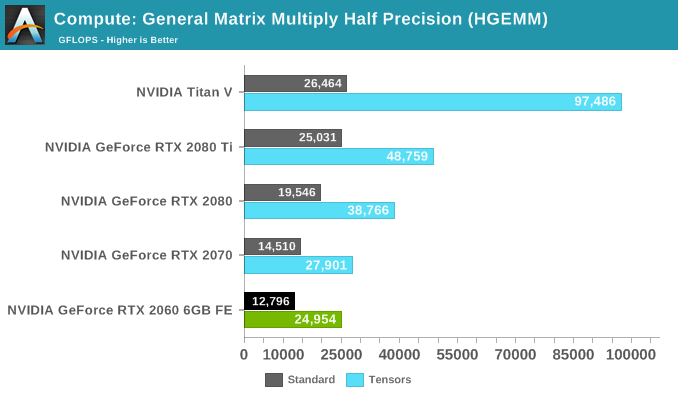
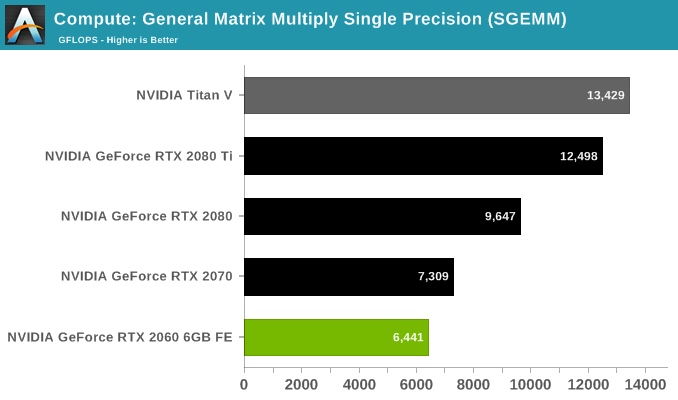
For Turing-based GeForce, FP32 accumulation on tensors is capped at half-speed, thus resulting in the observed halved performance. Aside from product segmentation, that higher-precision mode is primarily for deep learning training purposes, something that GeForce cards wouldn't be doing in games or consumer tasks.
Moving on, we have CompuBench 2.0, the latest iteration of Kishonti's GPU compute benchmark suite offers a wide array of different practical compute workloads, and we’ve decided to focus on level set segmentation, optical flow modeling, and N-Body physics simulations.
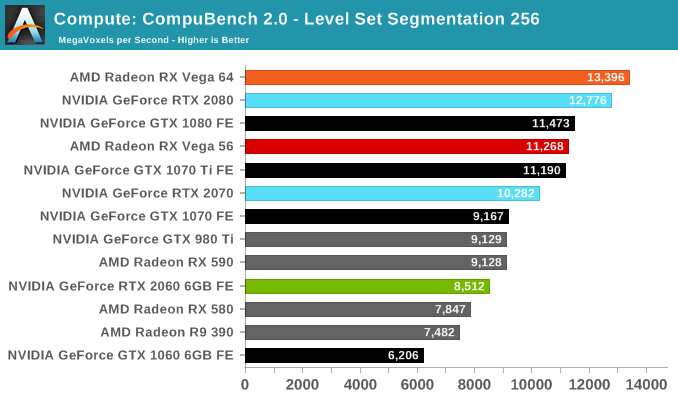
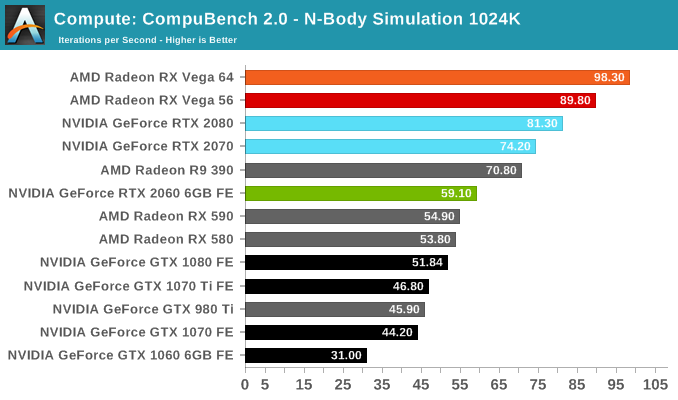
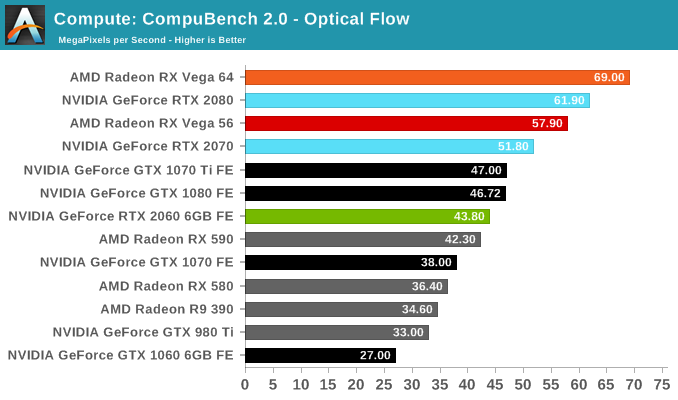
Moving on, we'll also look at single precision floating point performance with FAHBench, the official Folding @ Home benchmark. Folding @ Home is the popular Stanford-backed research and distributed computing initiative that has work distributed to millions of volunteer computers over the internet, each of which is responsible for a tiny slice of a protein folding simulation. FAHBench can test both single precision and double precision floating point performance, with single precision being the most useful metric for most consumer cards due to their low double precision performance.
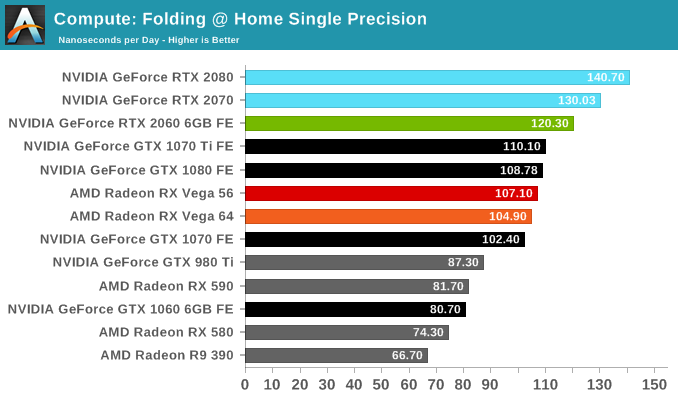
Next is Geekbench 4's GPU compute suite. A multi-faceted test suite, Geekbench 4 runs seven different GPU sub-tests, ranging from face detection to FFTs, and then averages out their scores via their geometric mean. As a result Geekbench 4 isn't testing any one workload, but rather is an average of many different basic workloads.
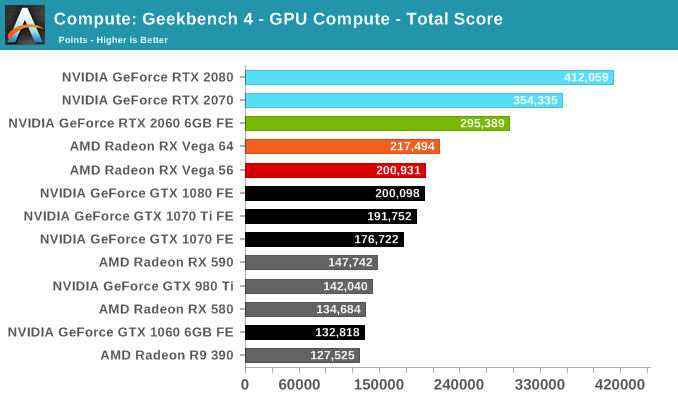
We'll also take a quick look at tessellation performance.
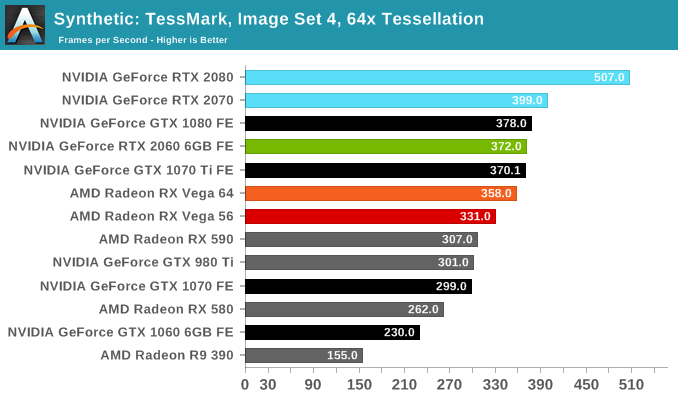
Finally, for looking at texel and pixel fillrate, we have the Beyond3D Test Suite. This test offers a slew of additional tests – many of which use behind the scenes or in our earlier architectural analysis – but for now we’ll stick to simple pixel and texel fillrates.
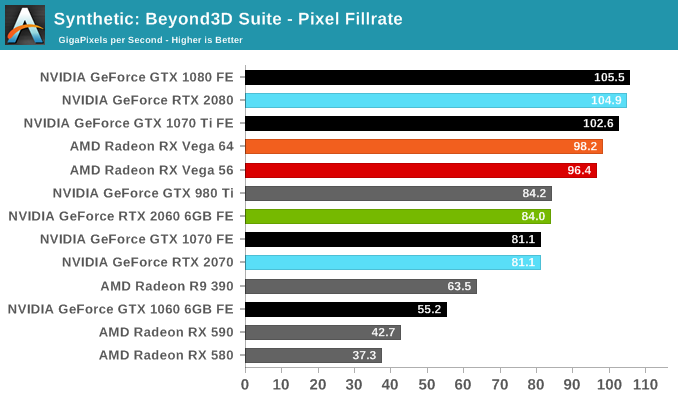
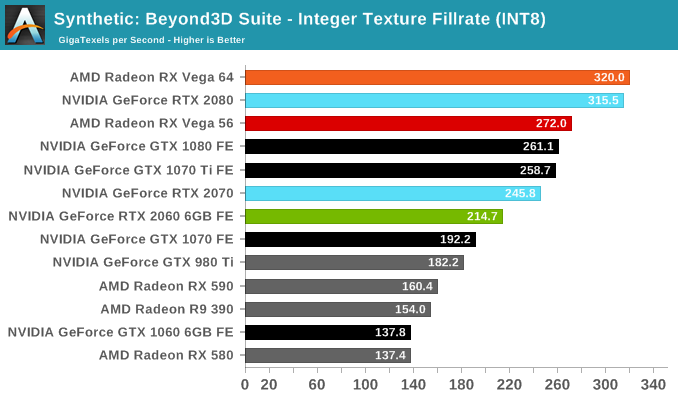










134 Comments
View All Comments
RIFLEMAN007 - Tuesday, January 8, 2019 - link
Those people can stick with the lower-end card, this card is in a separate class, why are people comparing them in the first place lol. This card should be compared with the Vega 56 on the AMD side....Manch - Tuesday, January 8, 2019 - link
That's a logical fallacy.10 gallons of premium gas ($2.60) is only 00.002498438476% more than regular ($2.50) in my $40K truck.
However for my my $500 riding lawnmower that would be .1904751904762%
If we were to take your example to the extreme, then you would need to add in the cost of electricity, factor in the percentage of your heating/cooling bill, house structure, lot, cost of living, price of your birth...and anything else that's a factor in the operation of the computer, because otherwise you would be making the common mistake of calculating price/performance as though computers operate without existence...
In actuality premium being typically 10 cents more per gallon is in fact 4% more, bc like GPU's you are comparing the product to a similar product.
In the case of the 580 & 2060, a 75% increase in price for 50% more performance with the caveat of DLSS & RT are also included.
CiccioB - Wednesday, January 9, 2019 - link
Yours is a fallacy in logic.You are comparing single time purchasing cost to expendable resources. Your logic in fact is good when you buy a serve class HW where the purchase cost of the mere HW is only a fraction of the cost of the entire cost needed to male it run, with energy and cooling system taking the bigger part of the bill.
Here we are saying that you have bought a $40K truck and adding that $50 comfortable chair is not that expensive instead of buying that other bare wooden chair.
Yes with the latter you would have $50 more in your pocket but at the cost of diminished comfort which you could have enjoyed for a $50/$40K % more in the truck purchase.
And yet, about consuming, buying an AMD card to have the same performance than nvidia's is going to use more "fuel" and so cost more as much as you use it for as long as you use it.
It's like buying a $40K truck engine that AMD has to sell at $10 to have the same performance and appeal (seen the fact that is not really that "smart") of a $20 muscle car.
You can see why many go directly for the $20 car despite the AMD discount on their crap product.
Manch - Friday, January 11, 2019 - link
Wow, OK. Pick anything not consumable then. Although a GPU can be considered expendable as they tend to go obsolete in the life time of a set of tires. Hardly a one time cost or do you not upgrade? The consumability of the product isn't the point nor does it have any bearing though.His point would be fine if you were comparing an entire system DIY or prebuilt system. Lets say a Dell vs HP. All things equal except for the GPU and the price reflected that, OK fine. But were comparing only the GPUs. @ 3k it's 4.7% @ 1.5K it's 11% of total cost. Then if were comparing system price, then total system perf comes into play not just the GPU perf. Thats the trap you both are falling into.
Lets be clear. I'm not advocating the AMD card or the Nvidia card. I'm merely pointing out the trap he and yourself is falling into with such an argument.
TBF if you're looking at a card with 2060 perf, then you're not considering the 580. If you're looking to make a 1080 gaming machine, the 580 is fine, the 2060 is overkill along with your 3K system.
eva02langley - Monday, January 7, 2019 - link
And cost 75% more. Also, we are talking about FPS so it is a non-linear comparison. Anyway it is still not awesome value.If Navi is 15% faster than a Vega 64 and cost 100$ less than a RTX 2060, you understand the 2060 RTX is still fairly overpriced. There is still no value here and you might be able to grab a similar card for less if you find a good deal.
D. Lister - Tuesday, January 8, 2019 - link
"If Navi is 15% faster than a Vega 64 and cost 100$ less than a RTX 2060..."What if it is 100% faster than Vega 64, and they give it away for free? Heck, what if they threw a big chocolate cake into the deal and Lisa Su personally came to my house to spoon-feed it to me while a hot chick cosplaying as Ruby stripped for my entertainment? C'mon, my fantasy may be slightly more unrealistic than yours but it is certainly a lot more fun.
CiccioB - Wednesday, January 9, 2019 - link
Problem is that most probably AMD has to price their high end card to that low price to have a chance to sell it.If, as it seems, Navi has not RT, DLSS, mesh shading (without speaking about multi-projection which helps a lot in VR, and Voxel effects acceleration which, alas, have not been developed up to now due to their lack of support on the crappy console HW) they will run only in the lower segment of the market.
Their possibly high frames will all be fake as the use of a single advanced effect supported by the competition will make them fall as fast as a falling lead stone.
Yet, we will have hoards of AMD fanboy crying out for the "Gameswork" tricks and bells and twists and nvidia payment to the developers an all the things we have already heard since AMD solutions have not been able to keep up with nvidia's advanced solutions that do not require simple brute force, that is since AMD acquired ATI, when the simple reality is that they have been behind in technological development and requires the market to slow down to not leave them in the dust.
zepi - Monday, January 7, 2019 - link
I don't know what mushrooms you are eating, but I want some of those as well.https://www.anandtech.com/bench/product/2299?vs=23...
RX580 is totally beaten by RTX 2060. Not quite double the performance, but not far from it. Not to mention perf/w, perf/money, noise, etc. characteristics, which are boatloads better than on the AMD card.
zepi - Monday, January 7, 2019 - link
Sorry, RX 580 noise levels seem to be quite reasonable. I've been watching mostly Vega since it is only thing that is actually a proper upgrade for me.sing_electric - Monday, January 7, 2019 - link
Not sure what you mean by "watching," but if you mean "waiting for a price drop," I wouldn't hold my breath. The HBM2 memory on those boards is significantly more expensive than the stuff found on Nvidia's, plus, the cards are very power hungry (which not only is a concern for the user, but also means that they need circuitry on board to deliver that large amount of power, which also adds to the cost to make the card).